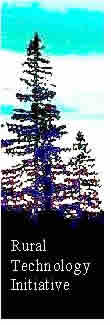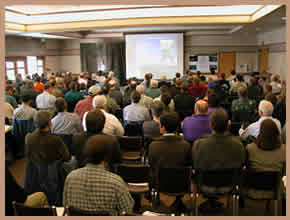 |
 |
 |
 |


Fall 2005, Volume 6, No. 1
Table of Content
A PDF copy of this Newsletter is available here!
|
| With
the support of the NCSSF grant, the riparian template was
further developed and tested and was shown to achieve good
results under a range of conditions. The applicability of
templates for other regions and management issues was then
examined, recognizing that the overall framework was not
limited to riparian management in the Pacific Northwest but
could be applied to other management issues and other regions.
To demonstrate the application for another region, an example
management template was developed for supporting increased
biodiversity in intensively managed loblolly pine plantations
in the South.
In southern forests, an open, park-like structure that supports a rich, herbaceous understory is desirable for biodiversity. This type of structure is characteristic of the fire-maintained longleaf pine forests that were prevalent throughout the South in pre-settlement times. Using a reference dataset representative of these conditions, a template was created that utilizes early and frequent thinning and prescribed burning over a 55-year sawtimber rotation. Projections of this template show it to be successful at achieving the desired stand structure. The rotation is longer than is typically the case in the South and while economic returns are not maximized, they appear to be fairly competitive, providing a reasonable balance of objectives. Low current pulp prices make production |
of higher-valued products over longer rotations more desirable, and increased opportunities for supplemental income from hunting leases may further offset costs. The example southern template demonstrates that the RTI template framework can indeed be successfully applied in other regions. This framework shows promise as a proactive approach to managing forests for multiple objectives in a way that minimizes economic impacts, management complexity, and the potential for unintended consequences. The complete report on this study can be found in RTI Working Paper #5, which is available on the RTI website or as a hard copy upon request. Fact Sheets on the southern template are available as well (RTI Fact Sheets #37 and #38). Also available is a streaming video version of a presentation that was given in Washington, D.C. to several groups, including the NCSSF Applications Workshop, staff for the House Committee on Resources, Forests and Forest Health, and the USDA Forest Service.
- Kevin Zobrist, RTI Staff - |
![]()
(RTI Promotes Technology continued)
The Twenty-Ninth Annual National Indian Timber SymposiumThe National Indian Timber Symposium is an annual conference that brings together tribal and BIA foresters from throughout the nation to discuss current issues that affect forest resource management in Indian Country. The 2005 meeting was held on June 6-9 in Visalia, California and was attended by representatives of 59 tribes and tribal organizations that manage timber. The symposium is organized by the Intertribal Timber Council (ITC), which was established in 1976 to provide a forum for promoting sound management of natural resources and tribal enterprises to sustain Indian forests and dependent economies in accordance with tribal goals and objectives. Each year the symposium is hosted by a different tribe in a different location. This year the Tule River Indian Tribe was the host. The Tule River Indian Reservation, most of which is mountainous terrain, comprises approximately 48,000 acres east of Porterville, CA, in the foothills of the Sierras. Tule River is the only reservation in the United States that has Sequoia trees on its land. The people of Tule River graciously welcomed symposium attendees and hosted a tour of their forestlands followed by a dinner with performances by traditional drummers, dancers, and singers. The primary objective of Tule River forest management is the removal of understory trees to reduce fire risk to Sequoias while creating jobs and generating revenue for the tribe. The theme of the 2005 Indian Timber Symposium was “Tribal Forest Resource Protection: Threats and Solutions”. Presentations included talks on invasive species, utilization of small diameter timber, biomass-to-energy from wood fiber, forest fire issues, stewardship contracting, tribal stumpage, tribal enterprises, and more. Each year high-achieving Native American students are awarded scholarships from the Truman D. Picard Scholarship Fund to further their educations in natural resource management. This year 14 students received awards. |
RTI staff members Kevin Ceder and Larry Mason presented an introductory short course on the use of the Landscape Management System (LMS) with tribal and BIA forest managers attending from the Warm Springs, the Yakama, the Menomonee, the Salish Kootenai, the Leech Lake Band of Ojibwe, and the Stockbridge-Munsee Community. This is the second year that RTI has had the honor of being invited to contribute to this important symposium, and we are grateful to have been asked to participate again in next year’s symposium, hosted by the Tanana Chiefs Conference in Fairbanks, AK (June 5-8, 2006). More information regarding the symposium and Indian forest management is available from the Intertribal Timber Council website.
- Larry Mason, RTI Project Coordinator - |
Forest Management in Indian CountrySince the Rural Technology Initiative was established in 2000, RTI staff members have had the privilege of working with many outstanding professional foresters from tribal natural resource programs and the Bureau of Indian Affairs towards meeting the technology transfer needs that are unique to Indian country. For me this has been an opportunity to renew old friendships, make new acquaintances, and learn a tremendous amount about the complexities of sustainable forestry on Native American lands. The hurdles faced by tribal resource managers are on one hand different from those faced by other private and public foresters, but on the other hand can be viewed as a microcosm of larger societal challenges replete with a diversity of opinions about how forests should be managed. Yet tribal managers are uniquely accountable, as tribal members rely on the management of their forests for employment, economic development, cultural resources, and healthy ecosystems. There is much to be learned from an examination of tribal forest enterprises in the United States and especially the Northwest where Indian nations have become a significant component of the forest industry infrastructure. There are approximately 18.5 million acres of Indian forestlands on 287 reservations held in trust by the United States. The Northwest region has the most productive tribal forests. In 2001, tribal forests in the Northwest accounted for more than 67% of the timber volume and more than 72% of the revenue generated from harvests on all Indian forests in the United States. Indian harvests in the Northwest have remained stable at just under 400 MMBF/year (an annual harvest volume close to that of the Washington Department of Natural Resources). |
In contrast to current divesture of forestland assets by many industrial forestland owners, tribes are increasing reservation forests through purchases of allotments and non-Indian lands and by reclamation of tribal titles. During the decade from 1991 to 2001, tribal forestland acreage increased in the United States by 2.1 million acres. In addition to expanding their forest holdings, some tribes have been investing in timber manufacturing enterprises. For example, in Washington State, the Confederated Tribes of the Colville Reservation operate a saw mill and a veneer plant which currently provide 300 jobs, 80% of which are held by Indians. The Yakama Nation operates two sawmills with 320 employees, 92% of which are Indian. The economic multipliers of Indian forest enterprises in Washington ripple throughout the state with substantial benefits for both native and non-native publics. If sustainability is to be the national goal for forestry in the 21st century, Native American successes in forest management could provide valuable insight on how to move beyond the resource conflicts of the last century. Next month, a special issue of Evergreen Magazine, created in partnership with the Intertribal Timber Council, will be dedicated to Indian forestry in America. With articles provided by 22 scientists and forestry professionals, this 80-page report will be a valuable contribution to the literature on forestry in Indian Country. For more information, contact Evergreen Magazine: www.evergreenmagazine.com or (406) 837-0966.
- Larry Mason, RTI Project Coordinator - |
Education website for forest and range landowners:The National Learning Center for Private Forest and Range Landowners is a nationwide initiative providing web-based education to landowners about sustainable natural resource management. Through a free and easy to use website, www.forestandrange.org, landowners from around the nation have access to interactive modules and other activities where they can find valuable information to help them manage their natural resources in a more efficient and sustainable manner. Topics currently include forest management, range management, wildlife management, estate planning, post-fire restoration, and others. The site is frequently updated with new topics. RTI will be contributing a learning module on forest finance in the spring of 2006. 
 |
**Notice** Due to the loss of funding for the RTI training program, all LMS, GIS, and GPS trainings have been cancelled through 2006. Oct 11 - Dec 6, 2005 December 3, 2005 |
Newsletter Delivery Preferences
|
Readers may send comments to:Editor, RTI News |







